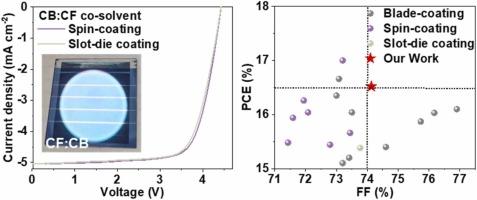Print-compatible morphology optimization strategy reduces the lab-to-module performance gap in organic photovoltaics
IF 17.1
1区 材料科学
Q1 CHEMISTRY, PHYSICAL
引用次数: 0
Abstract
Spin-coating technology remains extensively employed in laboratory settings for processing high-efficiency small-area organic photovoltaics. However, when scaling up from cell-level to module-scale fabrication, the spin-coating process-influenced by interfacial wetting behavior and film formation kinetics-produces non-uniform morphological characteristics across both macro- and micro-scales within active-layer films. To address this challenge, we introduce a co-solvent strategy incorporating chloroform (CF), a secondary solvent with lower boiling point and higher surface tension, into chlorobenzene (CB). This formulation optimizes interfacial wetting dynamics, enhances Marangoni velocity, and regulates film formation kinetics. Rheological analysis of the active-layer solution coupled with morphological characterization demonstrates that the co-solvent system enables effective regulation of the film deposition process, which yields uniform large-area films (25 cm2) with optimal phase-separated network structures. The resultant PM6:L8-BO:BTP-eC9 modules processed with co-solvent not only exhibit a notable efficiency of 16.52 % and a fill factor of 74.13 %, which is better than both pure CB- and CF-processed counterparts, but also present the impressive stability. Crucially, slot-die-coated modules fabricated using this co-solvent strategy maintain a competitive PCE exceeding 16 %, underscoring the critical importance of interfacial wetting optimization and kinetic control in developing high-performance, industrially viable photovoltaic modules.

打印兼容的形态优化策略减少了有机光伏电池的实验室到组件的性能差距
旋转涂层技术仍然广泛应用于实验室环境中,用于加工高效率的小面积有机光伏。然而,当从细胞级到模块级制造时,受界面润湿行为和成膜动力学影响的自旋涂覆过程在活性层薄膜的宏观和微观尺度上产生不均匀的形态特征。为了解决这一挑战,我们引入了一种共溶剂策略,将氯仿(CF),一种具有较低沸点和较高表面张力的二次溶剂,加入氯苯(CB)中。该配方优化了界面润湿动力学,提高了马兰戈尼速度,并调节了膜形成动力学。活性层溶液的流变学分析和形态表征表明,共溶剂体系能够有效地调节薄膜沉积过程,从而产生均匀的大面积薄膜(25 cm2),具有最佳的相分离网络结构。用共溶剂处理得到的PM6:L8-BO:BTP-eC9模块不仅效率为16.52%,填充系数为74.13%,优于纯CB-和cf处理的PM6:L8-BO - BTP-eC9模块,而且具有良好的稳定性。至关重要的是,使用这种共溶剂策略制造的槽模涂层组件保持了超过16%的PCE,这强调了界面润湿优化和动力学控制在开发高性能、工业上可行的光伏组件中的关键重要性。
本文章由计算机程序翻译,如有差异,请以英文原文为准。
求助全文
约1分钟内获得全文
求助全文
来源期刊

Nano Energy
CHEMISTRY, PHYSICAL-NANOSCIENCE & NANOTECHNOLOGY
CiteScore
30.30
自引率
7.40%
发文量
1207
审稿时长
23 days
期刊介绍:
Nano Energy is a multidisciplinary, rapid-publication forum of original peer-reviewed contributions on the science and engineering of nanomaterials and nanodevices used in all forms of energy harvesting, conversion, storage, utilization and policy. Through its mixture of articles, reviews, communications, research news, and information on key developments, Nano Energy provides a comprehensive coverage of this exciting and dynamic field which joins nanoscience and nanotechnology with energy science. The journal is relevant to all those who are interested in nanomaterials solutions to the energy problem.
Nano Energy publishes original experimental and theoretical research on all aspects of energy-related research which utilizes nanomaterials and nanotechnology. Manuscripts of four types are considered: review articles which inform readers of the latest research and advances in energy science; rapid communications which feature exciting research breakthroughs in the field; full-length articles which report comprehensive research developments; and news and opinions which comment on topical issues or express views on the developments in related fields.
 求助内容:
求助内容: 应助结果提醒方式:
应助结果提醒方式:


